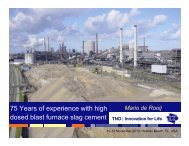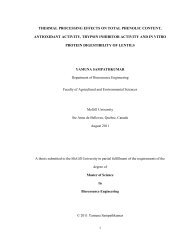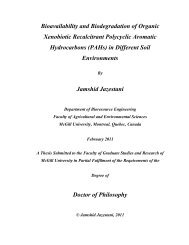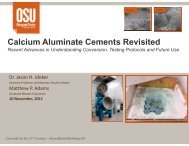Postharvest treatments to reduce chilling injury symptoms in stored ...
Postharvest treatments to reduce chilling injury symptoms in stored ...
Postharvest treatments to reduce chilling injury symptoms in stored ...
You also want an ePaper? Increase the reach of your titles
YUMPU automatically turns print PDFs into web optimized ePapers that Google loves.
AZRA TASNEEM<br />
ABSTRACT<br />
ii<br />
M. Sc.(Bioresource Eng<strong>in</strong>eer<strong>in</strong>g)<br />
POSTHARVEST TREATMENTS TO REDUCE CHILLING INJURY SYMPTOMS IN<br />
STORED MANGOES.<br />
The market life of many fruits and vegetables can be extended through s<strong>to</strong>rage at<br />
low temperatures. Chill<strong>in</strong>g <strong><strong>in</strong>jury</strong> (CI) is a major postharvest s<strong>to</strong>rage problem for tropical<br />
commodities. S<strong>to</strong>r<strong>in</strong>g these products at temperatures below their critical temperature may<br />
result <strong>in</strong> severe physiological disorders known as CI symp<strong>to</strong>ms. Mangoes (Mangifera<br />
<strong>in</strong>dica. L) are susceptible <strong>to</strong> CI when s<strong>to</strong>red below 12 ºC. Visual CI symp<strong>to</strong>ms <strong>in</strong>clude<br />
uneven ripen<strong>in</strong>g, surface pitt<strong>in</strong>g, discoloration, shrivel<strong>in</strong>g and scald<strong>in</strong>g. Research has been<br />
conducted <strong>to</strong> overcome these serious problems us<strong>in</strong>g various postharvest <strong>treatments</strong> such<br />
as hot water, methyl jasmonate (MJ) or diphenylam<strong>in</strong>e (DPA) with some reduction of the<br />
<strong>in</strong>cidence of CI symp<strong>to</strong>ms <strong>in</strong> fruits and vegetables.<br />
Experiments were performed <strong>to</strong> assess and compare the potential of the above-<br />
mentioned postharvest <strong>treatments</strong> <strong>to</strong> <strong>reduce</strong> the CI symp<strong>to</strong>ms on mango cv. Kent. The<br />
obta<strong>in</strong>ed results <strong>in</strong>dicated that MJ- and DPA-<strong>treatments</strong> gave significantly greater<br />
percentage of marketable fruits.<br />
Experiments were also conducted with mangoes cv. Tommy Atk<strong>in</strong>s treated with<br />
MJ and DPA before s<strong>to</strong>r<strong>in</strong>g at low temperatures (1, 4, 7 and 10°C). The chemical<br />
<strong>treatments</strong> were successful at reduc<strong>in</strong>g CI symp<strong>to</strong>ms of mangoes. Fruit decay was<br />
<strong>reduce</strong>d dur<strong>in</strong>g subsequent ripen<strong>in</strong>g. MJ-treated fruits had lower mass loss and higher<br />
<strong>to</strong>tal soluble solids (TSS) than the control treatment. The overall quality of MJ - and DPA-<br />
treated fruits was good with lower surface pitt<strong>in</strong>g and scald<strong>in</strong>g compared with the control<br />
treatment. The best results were obta<strong>in</strong>ed at s<strong>to</strong>rage temperatures of 7 and 10ºC. Both MJ<br />
and DPA postharvest <strong>treatments</strong> can <strong>reduce</strong> CI symp<strong>to</strong>ms <strong>in</strong> mangoes cvs. Kent and<br />
Tommy Atk<strong>in</strong>s when the mangoes are s<strong>to</strong>red at below critical temperature<br />
.









